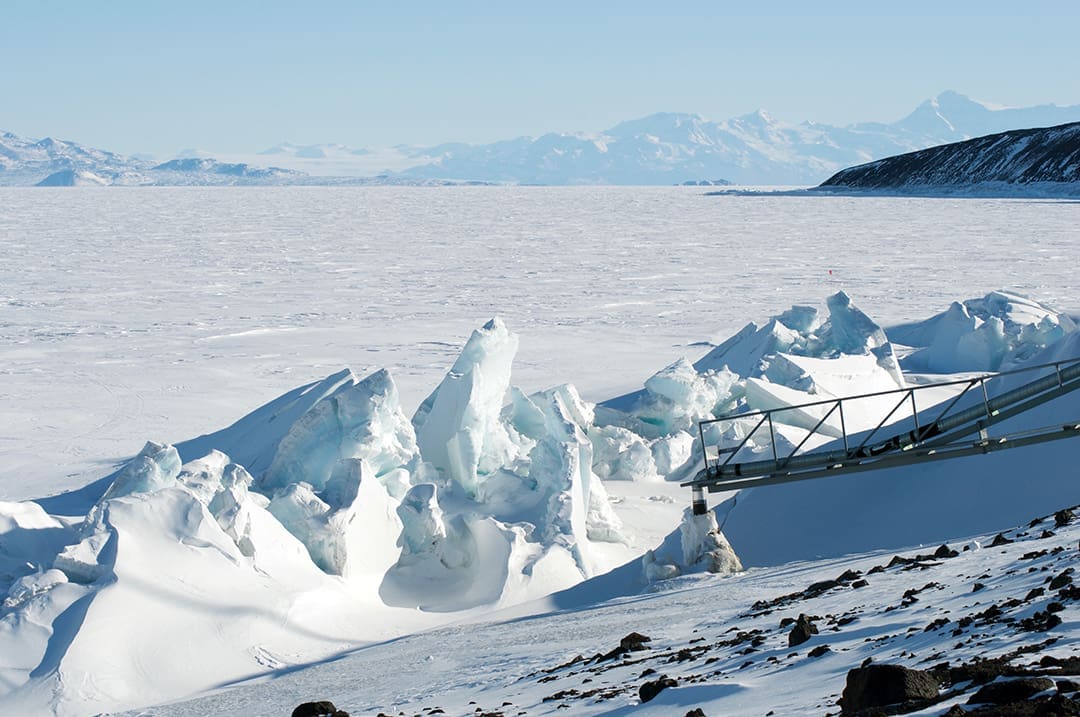Frankenstein on the Ice
Halloween Party in Antarctica
Early Halloween Party here at McMurdo last night. It seemed better to have the party on the weekend, with a busy week of science work kicking off on Monday. My two favorite costumes were…
- Full-body pajamas with a Chicago Cubs logo-I wasn’t sure if the fellow wore it as a Cubs fan (given their historic arrival in this year’s World Series) or if, like the irony of many Halloween costumes, he was mocking the Cubs. I didn’t have the courage to ask. It would have been a lose/lose scenario.
- Bride of Frankenstein- While I don’t know if this woman intended to provoke a literary reflection on Mary Shelley’s novel as it applies to Antarctica, nevertheless, it produced that result.
“I am the monster.” Ever since a student in my brother’s Humanities class made this observation, Mary Shelley’s novel continues to find its way into my thoughts. The student was comparing the class visit to a remote, mountain community in Nicaragua with the story of Shelley’s monster observing a poor family in the forest. The monster runs away from Victor, the scientist who made him. The monster flees into the wilderness to study the kindness, self-sacrifice, and love of an illegal immigrant family struggling to survive. He is inspired by how they care for each other, but he also knows that he will never be able to be like them.

I am here in Antarctica with the National Science Foundation’s Artists and Writers Fellowship. I am a composer that left home to live in a remote wilderness among world class research scientists. I admire their scientific skills and knowledge, but I can never quite do what they do. To NSF’s credit, this fellowship was created to get artists and scientists working together for mutual benefit. Nevertheless, I feel a little bit like the monster here, looking upon their inspiring work as an outsider.
The monster has much more to say to us in Antarctica. Shelley’s novel explores the often dangerous frontiers of scientific achievement. A sea captain named Walton stumbles upon Victor and the monster during his exploration of the Artic. Looming behind this complex story is Walton’s decision to either endanger the lives of his crew for his own achievement and recognition or to turn around and bring the crew home safely to their families. Victor, consumed by the unfettered lust for glory, scolds Walton for his weakness and predicts that Walton will return home as a disgrace to his country and family. Victor is the example of what NOT to do. NSF works tirelessly to keep their people safe in this unforgiving environment. The rarity of accidents here is testament to their vigilance in protecting all of us from the environment and our own bad decisions.
Shelly also turns the Hebrew creation story inside out by staging the final battle between Victor and the Monster on the Arctic sea ice. Rather than the Creator in the Book of Genesis bringing life out of darkness and proclaiming it “good,” Victor brings life out of death and calls it “disgusting” and “horrible.” Rather than the Creator and the creation sharing a lush, seemingly tropical garden of Eden, Victor and the monster play out their mutual resentment in a barren icescape.
Her technique of teaching through negative example helps me better understand this place. Victor is the mirror image of a good scientist. At the most basic level, a good scientists name their discoveries after themselves or the patrons. The contemporary version of this includes the requirement to give credit to NSF for the good work that they support. Victor never names his ultimate achievement. He calls him a “monster” and a “devil.” Please know that popular horror movies have conflated Victor’s surname “Frankenstein” with the monster, so we must remember how the name is used in the original text.
Furthermore, good scientists nurture their experiments through the dialogue of successes and failures that move our knowledge of nature forward. Victor rejects his creation and seeks to destroy it. Good scientists examine the results of their work (and the work of their peers) with objective analysis that articulates a truth beyond the perspective any individual. Victor responds to his creation with wild emotional outbursts, self-destructive behavior, and a heavy dose of delusional assumptions that he can physically harm a super-human monster. In fact, the monster often comes off as more logical and reasonable than Victor in many of their exchanges.
Finally, the stage on which Victor and the monster perish is the barren, Artic sea ice. At the time that Shelley wrote, “Frankenstein,” exploration of the poles was in its infancy. European nations became increasingly interested in both the commercial possibilities of polar exploration (mostly in the whaling industry and international trade) as well as the glory for God and country that went along with pushing back the frontiers during the 19th century. That being said, the ice provides a stark setting for the tragic ending of her novel. Shelley contrasts this lifeless environment with the abundant fruitfulness of the Garden of Eden. With the exception of the occasional Skua (a large, brown sea gull-like bird) and sightings of penguins or seals, the surface of Antarctica, like Shelley’s Artic stage, is largely bereft of life. However, there is a crowded, vibrant ecosystem that thrives underneath the ice that pushes back on the stereotype of a lifeless Antarctica. There is a thriving garden of plants and animals that comprise a complex ecosystem visible to only those willing to venture into its icy depths. That will be the subject of my next blog.
A good book is good anywhere. But reading a good book in an interesting place makes it better.

